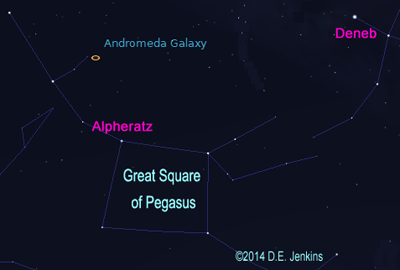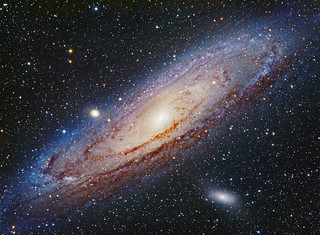
September 2014 - Vol. 18, No. 9
This Month's Night Sky - NOTE: The next paragraph describes the sky as it appears at 10 pm EST (11 pm EDT) near mid- month. The sky also looks this way at 11 pm EST (midnight EDT) during the beginning of the month and at 9 pm EST (10 pm EDT) by month's end.
The Summer Triangle asterism, Vega (Lyra), Deneb (Cygnus) and Altair (Aquila), is still quite prominent overhead as darkness falls. Arcturus (Bootes) is now dipping to the NW horizon. From a dark site, the myriad stars of the Milky Way (the visible "arm" of our galaxy), "flow" eastwards through the "W" asterism of Cassiopeia and to bright Capella (Auriga) glowing in the NE. "The Great Square of Pegasus" asterism burns high in the SE while lonely Formalhaut (Piscis Austrinus)shines far below, very close to the horizon. "The Big Dipper" asterism (Ursa Major) is nearly horizontal and now sits low on the N horizon. In the E, Aldebaran (Taurus) shines, a sure sign of Autumn.
MERCURY in the evening sky favors observers in the southern hemisphere. A good horizon might reveal Mercury just after sunset near Spica in Virgo. VENUS will be low in the early morning sky, disappearing into the solar glare this month heading for superior conjunction in October, she will reappear in the evening sky in December. JUPITER is still low in the morning twilight. MARS and SATURN are also closing in on the Sun, after spending many pleasant Summer nights granting sky observers a wonderful planetary show, both set before midnight this month. Watch these two as they interact with the bright stars of Scorpius and Virgo.
Review how to determine Angular Measurement.
Calendar of Events
NOTE: For those observers not in the ET zone, convert the calendar times to your zone's time by subtracting one hour for CT, two for MT and three for PT. Don't forget to adjust for Daylight Savings Time when necessary by subtracting one hour from your planisphere's time. Dawn and dusk times must also be corrected. See your local newspaper, TV news, or cable TV's Weather Channel for sunrise and sunset times. Unfortunately some of these events may occur during daylight hours in your area.
| DATE | EVENT |
| 01 | Mars 4 deg S. of the Moon. |
| 05 | Venus at perihelion. |
| 08 | Moon at perigee may cause large tides. This is the night of the "Harvest Moon." |
| 11 | Uranus 1.1 deg S of Moon, occultation from Eastern Canada, Siberia and Greenland. Look for a nice lineup of Jupiter and Venus just before sunrise. |
| 15 | Aldeberan 1.4 deg S. of the Moon. |
| 18 | The Zodiacal Light or "false dawn" is visible in the E about 2 hours before sunrise. This pyramidal glow is caused by meteoroids, dust particles spawned by passing comets, etc., that have settled into the ecliptic plane (path followed by the Sun, Moon and planets), reflecting the Sun’s light before it rises here. This phenomenon will be visible until about October as long as the Moon does not interfere. |
| 20 | Jupiter 5 deg N. of Moon. Moon at apogee. |
| 23 | Equinox, the first day of autumn. |
| 24 | Venus 6 deg N. of Moon. |
| 26 | Mercury 4 deg N. of Moon. |
| 27 | Mars 3 deg N. of Antares. Mars will be close to Alpha Scorpii, the red star, Antares, just after sunset for the next few days. They are close to the horizon, and it will be a challenge to compare how red they are depending on your site and atmospheric conditions. |
| 28 | Saturn .7 deg S. of Moon, occultation Eastern Asia, Japan, NE Russia and Hawaii. |
| 29 | Mars .6 deg S. of Moon. |
Lunar Almanac for September 2014
| Phases of the Moon | Phase and Date(s) | Best viewed before local midnight |
 |
New 24 |
Deep Space Objects |
 |
1st. Qtr 2 |
Planets & Moon |
 |
Full 9 |
Moon |
 |
Last Qtr 16 |
Deep Space & Planets |
Deep Sky Splendor: the Andromeda Galaxy
The fall sky is filled with the bright star clouds of the Milky Way running from the south western horizon toward the north east through the constellations of the Summer Triangle, that is now past the zenith for northern locations when the last gasp of twilight fades. Following the triangle, a Great Square formed by four fairly bright stars, one of them Alpheratz that really belongs to a neighboring constellation.. Galloping toward zenith, Pegasus, the flying horse carries with it the most distant galaxy that is easily visible by the naked eye.

Known as M31, or the Andromeda galaxy is the brightest object outside of the Milky Way that is easily visible with the naked eye. It is a whopping 2,538,000 light years away and still covers 3 degrees of the night sky. In contrast, the full moon only covers half a degree.
Andromeda is a spiral galaxy, 110,000 light years in diameter containing a trillion stars. It is a splendid object from a dark site. Field glasses will reveal a well-formed oval cloud, because the spirals tipped about 15 degrees toward the Earth rather than edge-on or facing. Even so, an amateur telescope can reveal its central nucleus and good images reveal the dark veins of its spiral arms. Classified as a Sb spiral, the galaxy’s central bulge is composed of yellow stars while blue stars are more concentrated in its arms.
Andromeda and the Milky Way galaxy, along with M-33 in Triangulum, are the largest members of our Local Group that is, a number of galaxies that are gravitationally bound. The Local Group is thought to contain about 30 members, most of these are dwarf galaxies like the Large and Small Magellanic Clouds visible from the southern hemisphere. The “Clouds” are dwarf galaxies that are tightly bound to the Milky Way. Andromeda also has a number of dwarf companions. Notably, NGC 205 and M32 are often visible on images with the main spiral. There are two more members of Andromeda’s family, NGC 185 and NGC147 that are located in the nearby constellation of Cassiopeia.
This image is a composite of images of the Andromeda galaxy and the two nearby companions that were taken by Terry Hancock in August of 2012 and edited to produce this beautiful result. Visit Terry's Down Under Observatory for great astrophotos that may be purchased. You may also like Terry's "Sagittarius Starscape" featured on theAstronomy Picture of the Day (APOD)site on September 5, 2014! Many thanks to Terry for sharing this astrophoto with readers of the What's up? almanac!
It is possible that Andromeda and Milky Way collided 10 billion years ago and it is also possible that they will collide again in another 4 billion years. Although this collision might mean the end of Milky Way and Andromeda, it may be that a new, larger elliptical galaxy will result. In any case, we can sit back and enjoy the sight of this massive, distant spiral from a deep sky site free from worry. Some night when the conditions are just right and the site is dark enough, you might catch a glimpse of a huge oval cloud that you'll never forget.
--See You Under the Stars!
Astra for Astra's Almanac
This installment of "Whats Up?" is ©2014 by Dawn Jenkins for Astra's Stargate. View Ron Leeseburg's Farewell Issue for information on where to find information such as is presented in this almanac.
